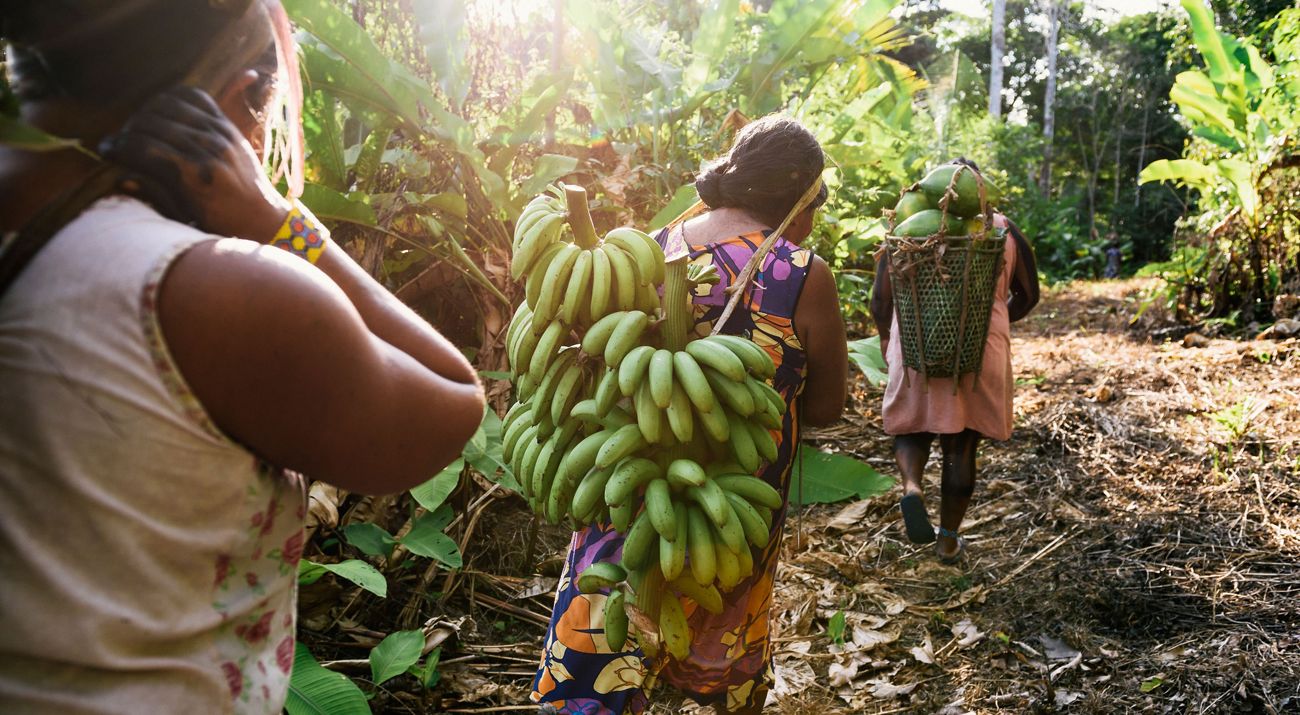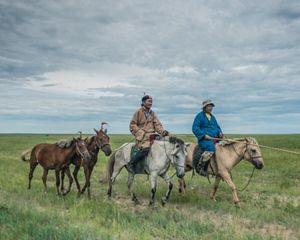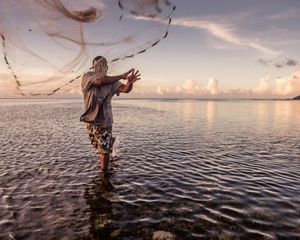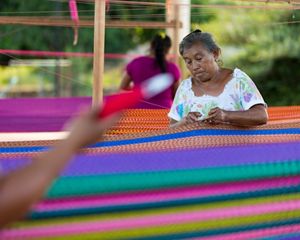Indigenous Women: Keepers of the Amazon Rainforest
By Luciana Lima, Field Manager, Xingu, TNC Brazil, and Eduardo Vieira Barnes, Indigenous Policy Specialist, TNC Brazil
"Menire!"
The voices of hundreds of Xikrin women echo through the indigenous land on the edge of the mighty Bacajá River. The women respond to the call, flocking to the ngàb, the main house, to discuss their roles and daily activities together, with children, dogs and chickens in tow. These women (Menire, in Xikrin) are the heart of their community—and important stewards of its natural resources.
The Xikrin Indigenous People of Bacajá, numbering 1,067 people, live in 15 villages in the Trincheira Bacajá Indigenous Land, a territory spanning 1.65 million hectares in Brazil's Pará state in the heart of the Amazon Rainforest. A massive natural carbon sink and haven for biodiversity, the Amazon is undoubtedly one of the most important ecosystems in the world—and indigenous lands are the foundation stone to its protection, comprising over 27 percent of the land area in the Amazon Basin and holding 33 percent of its carbon reserves.
From 2000 to 2012, deforestation in indigenous lands in Brazil was less than 1 percent, compared with 7 percent deforestation and 27 times more carbon dioxide emissions from deforestation outside them. Indigenous peoples’ wisdom and understanding of the ecosystem and natural resource management is key to ensuring resilience in the face of immense pressures—and not just in Brazil.
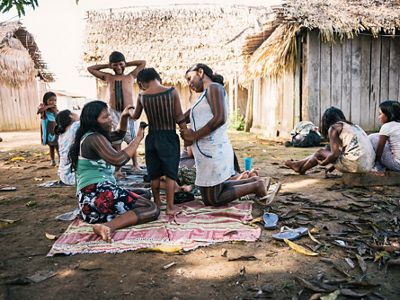
Indigenous communities manage approximately 25 percent of the world’s lands, and these areas house an outsize share of the world’s biodiversity and natural carbon stores. In fact, the newly released IPCC Special Report on Climate Change and Land notes the importance of indigenous knowledge for developing strategies to improve agricultural practices and mitigate land-based climate emissions. The message is clear: strengthening indigenous institutions is not only a human rights issue—it’s also crucial for achieving global climate and biodiversity goals.
Indigenous women’s knowledge and leadership is particularly important for achieving positive outcomes for people and nature. A 2016 systematic review of the science literature suggests that including women in natural resource management leads to better governance and conservation. But despite their critical role in natural resource management, women are often marginalized from decision-making processes, and their work goes unacknowledged.
Observing that their responsibilities were often seen both inside and outside the village as secondary roles, the Xikrin Menire set out to gain stronger recognition of their roles as natural resource managers, as well as opportunities to lead other types of projects in their communities. Their goal was to organize themselves and engage supportive partners, to grow their knowledge and skills and increase their visibility within their communities and in the world of the kuben (white people). With many of their roles and interests centered on sustainable natural resource management, supporting the Menire’s vision and leadership is a natural and long-term solution to improve environmental and human well-being.
Quote: Xikrin Menire
We, Xikrin women, are very important and have to be valued within and outside our villages. This isn't an argument; it's our right.
The women began this journey 5 years ago, with a diverse portfolio of sustainable resource management and production projects in partnership with the Brazilian government's National Indigenous Peoples Foundation (FUNAI), The Nature Conservancy (TNC), the Plan for Regional Sustainable Development in Xingu (PDRS Xingu) and traditional ribeirinho communities in Rio Novo. These women-led projects—including dress-making, dye creation for body paint, flour production and vegetable cultivation—all support the sustainable harvest of non-timber forest products, in turn leaving the forest standing strong. Many of these projects continue on today.
One project that has expanded and is now being implemented in several Xikrin villages is babaçu oil production (a type of coconut). The project centers on strengthening the Menire’s capacity to manage the production and commercialization of the babaçu for use within the villages and for external commercialization. The oil is sold at fair prices and routed directly to consumers or stores in urban centers, cutting out the middle man and adding significant economic value to an activity of cultural and environmental importance.
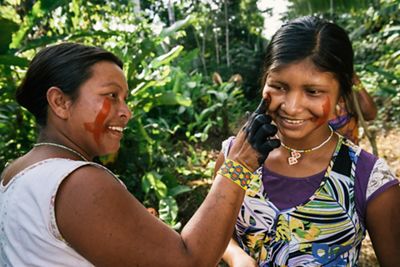
This project has also included the establishment of a new nhô rõny kangõ nhõ kikre (babaçu oil processing house) and a small oil extraction machine. Processing babaçu oil for cooking and cosmetic purposes is a traditional role of the Menire that dates back generations; now it's providing the opportunity for greater leadership, income and recognition for the Xikrin women and their villages. The project recently received recognition from the United Nations Food and Agriculture Organization (FAO) for women's empowerment and autonomy in rural activities that promote healthy and traditional foods.
"I was chosen by the women of my and other villages to be a leader in these management activities, to always fight not only for myself, but for all Menire. These lessons come from my grandfather (former leader) and my mother Ngrenhkarati Xikrin – who carries these lessons with her today – and I want to continue with this learning journey, too."
Kokoté Xikrin – Xikrin leader from Potikrô village
Indigenous women are the leaders of a promise to future generations. Mothers, grandmothers, great-grandmothers—all women in the community—share an important understanding of and responsibility for forest resources, which are critical for food security for the entire family, and for sustainable management of community resources. In the Xikrin People’s Territorial and Environmental Management Plan (PGTA—developed in partnership with TNC), the Menire emphasized the importance of strengthening commercial management of non-timber forest products, such as the piy (Brazil nut). The entire family participates in the processing of the piy, including collection, washing, transporting and storing.
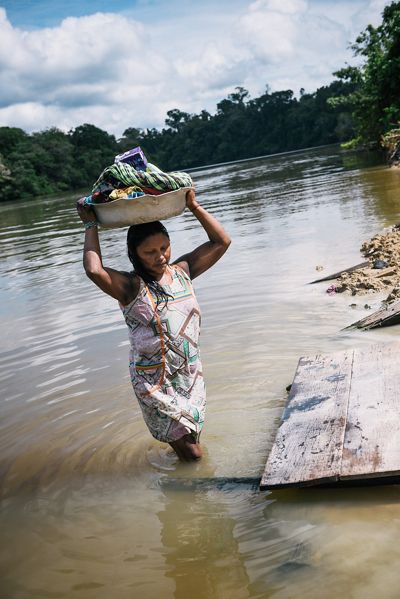
TNC also supports other indigenous peoples in managing and commercializing resources like the Brazil nut, including the Parakanã Indigenous People in the Apiterewa Indigenous Land, neighboring the Xikrin. As with the babaçu oil project, the Xikrin and Parakanã People are now selling the Brazil nut directly to the industry, for example to a bread factory, removing intermediary buyers and thereby receiving higher prices. The Parakanã People are also developing a strong commercial supply chain for their traditional crafts, selling them for an added value and to a market with stable demand. This in turn provides a constant flow of income that goes directly to the women, who use it to improve the lives of their families and villages and ultimately to strengthen Parakanã autonomy on their land.
The increasing visibility of indigenous women’s leadership in indigenous associations and institutions at all levels across Brazil is leading to large-scale results: Today, the Coordination of Indigenous Organizations of the Brazilian Amazon (COIAB) and the Articulation of Indigenous Peoples of Brazil (APIB), for example, are represented by strong women leaders who promote both indigenous rights and environmental sustainability at national and regional scales.
When the connections among conservation activities, gender equity and indigenous rights are understood, acknowledged and addressed, conservation activities have a much higher potential for generating positive social impacts and contributing to more enduring conservation outcomes. Supporting indigenous women to thrive in ways they determine as culturally appropriate and aligned with their vision for the future is key to ensuring the conservation of millions of hectares of ecologically critical lands across Latin America and around the world.
Learn More About TNC's Work with Indigenous & Local Communities
Global Insights
Check out our latest thinking and real-world solutions to some of the most complex challenges facing people and the planet today.
